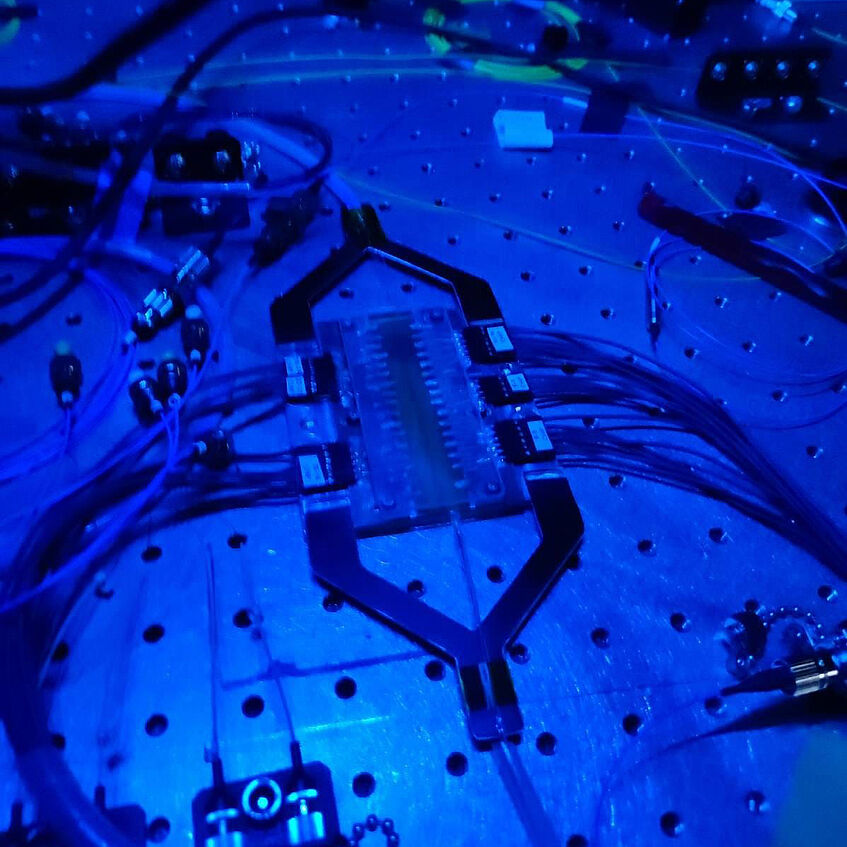Quantum Maschine Learning & Quantum Neuromorphic Computing

Integrated circuits

Integrated circuits, consisting in waveguides drawn in a substrate of borosilicate glass, with a layer of gold on the surface. The metal implements resistive elements which allow to program the devices. This is particularly suitable for adaptive protocols, like machine learning training.
Quantum Maschine Learning & Quantum Neuromorphic Computing
Quantum computing has brought a change of paradigm in the field of computer science, with the promise of outperforming its classical counterpart.
However, until today, the only proven speed-up over classical computational models concerns tasks that are either out of reach for current technological capabilities (e.g. factorization of large integers through Shor’s algorithm) or that have no practical applications (e.g. Boson Sampling).
Another revolution within computer science has been brought by machine learning, where models learn how to perform a given task from “experience”, i.e. by processing example data. Then, if the learning process is successful, the model can perform the same task on new, previously unseen, data. Nowadays, machine learning models are at the core of our everyday lives, from email filtering to medical and research purposes.
In our group, we investigate how to combine the two fields of quantum computing and machine learning in a fruitful way, by designing the quantum version of machine learning algorithms. This research line can be considered an instance of “quantum machine learning”, with our current focus being on hybrid quantum-classical protocols that are within the current quantum technological capabilities. To this aim, we take advantage of the versatility of photonic platforms, mainly resorting to integrated circuits. Our goal is, on one side, to look for potential advantages brought by the quantum hardware, and, on the other, to tackle tasks that have no classical equivalent.
The main quantum machine learning models that our group investigates are reinforcement learning, where an agent learn from the contacts with the environment (through rewards and penalties); reservoir computing and kernel estimation, where data is nonlinearly mapped into a higher dimensional space, to make its post-processing computationally easier; and data reuploading, where input data is given to the model multiple times, to enhance the overall performance accuracy. Most of these protocols rely on the ability of applying nonlinear mappings on the input data (which is the most demanding task from a computational point of view). However, this is hard to implement on quantum platform, as the evolution of closed systems is linear.
Hence, a core point of our research is to investigate how non-linear operations can be implemented on quantum hardware and on photonic platforms. This research line holds particular interest, since photonic platforms have proven to require lower energy consumption than standard models. In this framework, we are investigating novel photonic devices, e.g. the quantum memristor, which displays the hysteretic behavior of neural synapses. This architecture might prove particularly useful for neuromorphic computing, which aims to design protocols that are more resource efficient, mimicking the function of the human brain. Our research paves the way also to quantum inspired machine learning models, towards higher resource efficient computation.
Publications (selected)
Experimental photonic quantum memristor
M. Spagnolo, J. Morris, S. Piacentini, M. Antesberger, F. Massa, A. Crespi, F. Ceccarelli, R. Osellame, P. Walther,
Nature Photonics 16, 318–323 (2022).
Experimental quantum speed-up in reinforcement learning agents
V. Saggio, B.E. Asenbeck, A. Hamann, T. Strömberg, P. Schiansky, V. Dunjko, N. Friis, N.C. Harris, M. Hochberg, D. Englund, S. Wölk, H. J. Briegel, P. Walther,
Nature 591, 229–233 (2021).
